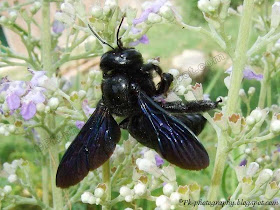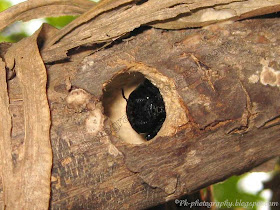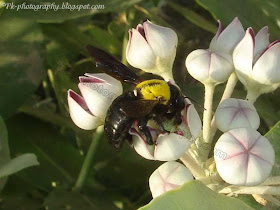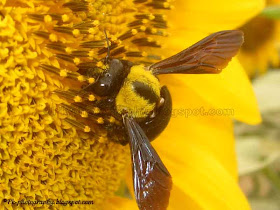 |
| Carpenter Bee |
Carpenter bees ( genus: Xylocopa, subfamily: Xylocopinae, family: Apidae) are solitary bees i.e they live individually rather then colonies. However some species have tendency to live in simple social group. They have large (up to one inch) hairy bodies and found in shiny black, yellow or metallic blue color. They are named carpenter bees because they bore tunnels in wood to make their nests. They feed on pollen and nectar from flowers and thus play an important role in pollination of flowers and trees. However they also damage wood. Their damage to wood initially is minor, however repeated use for many years of the same wood can eventually cause considerable wood damage as they enlarge an existing burrows. The male bee does not have a stinger and thus are harmless to human. The female carpenter bee does have a stinger, but sting only if captured or handled.
Carpenter Bees
 |
| Carpenter Bee Nest |
 |
| Carpenter Bee Stinger |





We have tons of carpenter bees around our farm. I usually see them sawing into the bottom of the blooms on my flowers, disconnecting them from the stem--the little buggers! I haven't seen any tearing into the wood on our house or other structures.
ReplyDeletethey sometimes visited my lawn too. They visited my lawn in springs. hm may be in mid march.They mostly visited sweet pea flowers grown in winter months upto springs.
ReplyDeleteWOnderful shots and information Birdy. I always love to see them in the garden.
ReplyDeleteThanks Shelly Cox for the comment and information. I never saw them cutting blooms from the stems. I guess this will be a certain specie of carpenter bee unluckily present in your area. The wood on your house will be hard enough for them to burrow or it will be treated or painted for the protection against these bees.
ReplyDeleteThanks Rabia Akram for your visit and sharing your valuable words.
ReplyDeleteThanks Joan for the comment and appreciation. I also love to watch nature in action.
Wow! Nice capture I must say...
ReplyDeleteGreat shots of the carpenter bees, especially the solid black specimen.
ReplyDeleteCarpenter bees are also abundant here. I have several nesting in the rafters of my porch. They are interesting to watch and I figure they won't do any severe structural damage in my lifetime.
As Shelly mentioned, the carpenter bees also cut into many of our flower stems. Because they have short, stout mouth parts made for boring into wood, carpenter bees cannot get to the nectar is small, trumpet-shaped flowers. Therefore, they gain access to the nectar by cutting into the stem right behind the flower in a practice known as nectar robbing.
Very interesting blog!!! i liked it, most of all for the new ideas that this blog talk. I must to say it catched my attention since the first time that i read it. I usually like everything that can give me what i am looking for.
ReplyDelete